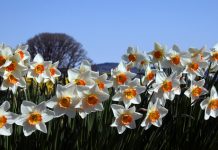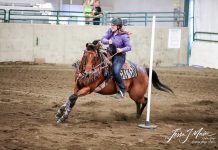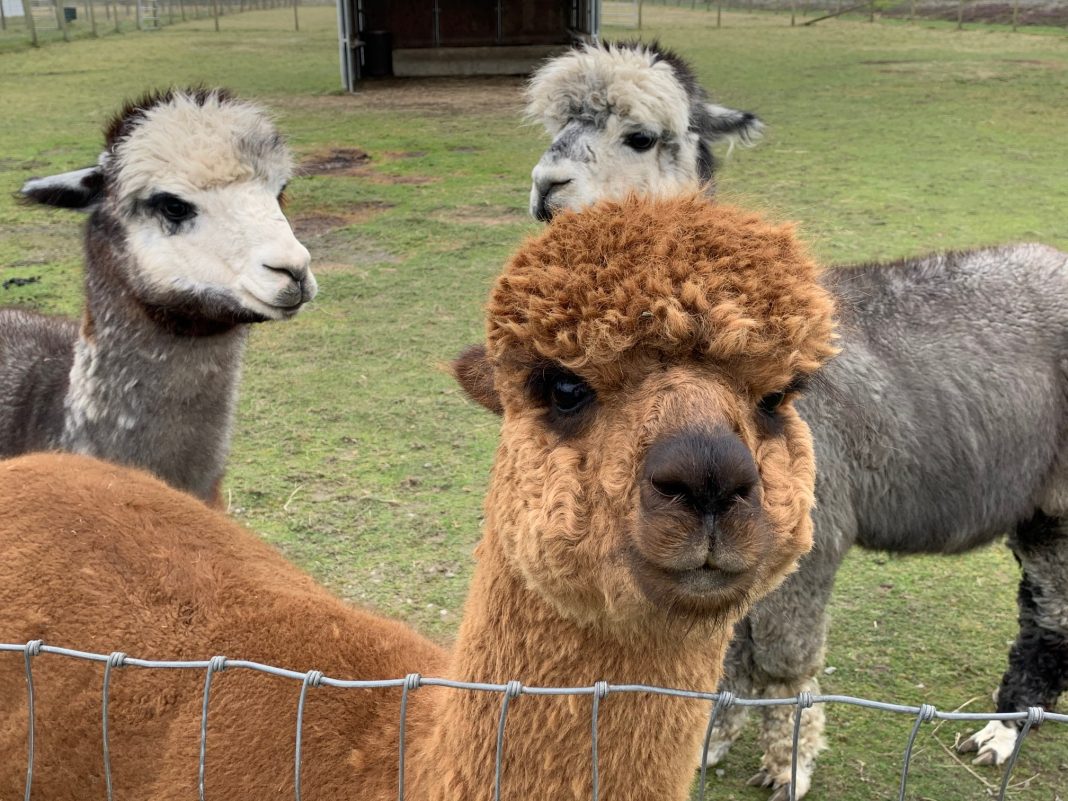If you’re like a lot of people, you know one thing about alpacas: they’re cute as can be. Or perhaps you’re one of many who still can’t tell an alpaca from a llama. Whatever the case, take a drive along Dike Road just south of Mount Vernon and visit South Fork Farms. The Wiegand family will welcome you and introduce you to all things alpaca.
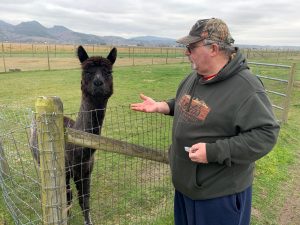
Gary and Ruth Wiegand say they feel very fortunate to have grown up in this area and they deeply appreciate having had the opportunity to make a go of it as a third-generation farm. Ruth’s grandfather, Ole Lee, arrived from Norway in 1876, in the pre-dike days of the Skagit Valley. His family operated a registered, purebred Holstein dairy farm and planted crops in the sandy river bottom soil. Ruth’s mother inherited the farm, then passed it along to Gary and Ruth.
Alpaca Love
Noticing how much the two love their alpacas, it’s a surprise to learn that they weren’t sure what to raise at first. They knew they wanted to do something on the farm, explains Gary. “And we thought about cattle or pigs,” he says. They attended their first alpaca show in 2004 and the matter was settled. They purchased four bred dams (females) and launched the operation.
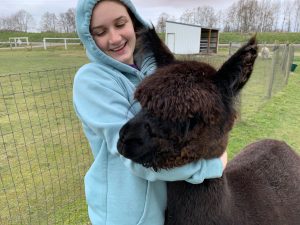
With help from their daughters, Aleena and Sydney, the couple expanded the business rapidly. Their love for the curious, gentle animals they raised grew quickly too. Sharing the story about selling an alpaca born on the farm at the first competition they entered, Ruth remembers, “I cried all the way home.”
The Family Farm
The whole family got involved in caring for the animals. Both girls have belonged to 4-H, raising and showing their alpacas, and the four Wiegands participated in Alpaca Owners & Breeders Association shows, the girls starting at age 7. In their busiest time, the family had a herd as large as 50 at South Fork Farms.
Today the operation is a bit smaller. Gary and Ruth still sell animals. Nearly a dozen have been sold in the past two years. There are a variety of reasons people purchase alpacas, most are intended as breeding or companion animals. Gary does recall selling several alpacas to a local farm-based group helping veterans with PTSD. “The calm animals are perfect for the veterans to work with,” Gary believes.
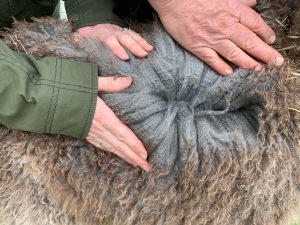
The Finest Fiber
Nowadays, the Wiegands have turned most of their attention to producing the finest quality alpaca fiber, having never lost a local fleece competition, Ruth shares. Like its larger cousin the llama, alpacas are native to the Andes. Clothing made from their fiber was once reserved for Inca royalty due to its many desirable qualities:
- It’s comparable to cashmere and mohair—fine, soft and elastic.
- Air pockets within the fiber make it warm, light and breathable, and it dries quickly.
- It comes in 16 natural colors, from true black and white to fawn, grey and rose grey.
- Due to an absence of lanolin, it’s washable without chemicals and wearable without discomfort—it’s nearly hypoallergenic.
At South Fork Farms, you can learn firsthand why alpaca fiber is prized by spinners and fiber artists. “See that coat that looks like a bowl of popcorn?” Gary asks, pointing to Faith, a white female. Indeed, the fleece on Faith’s back is incredibly soft, and long too. If you push your fingers into her coat, they sink in to the third knuckle. “The fibers should be about three to five inches long,” Gary says. Alpacas are shorn once a year in spring, producing one to eight pounds of fiber.
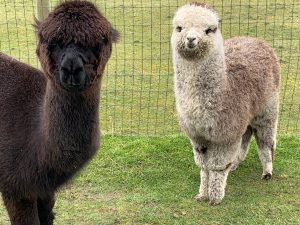
Those Faces!
Alpaca offspring, called cria, are born in summer and weigh between about 10 and 20 pounds. They are all neck and legs at first, says Gary. The youngest animal on the farm now is Finley, a rose grey little boy whose smooshed face looks like he’s always grinning. Sydney will begin halter training him soon.
Though alpacas are mild-natured, they are herd animals and need time to become accustomed to contact with humans. Once completely tame, maintenance such as toe trimming and vet visits are easier for animal and human. Alpacas appreciate soft voices and gentle movements.
The personalities of the dams, sires and juveniles vary just as you might expect. Many are curious and will approach the fence when you visit. You can count on Mercy, a dark fawn-colored dam, and sires Grayson, Remington and Rebel’s Rouser to greet you and see if you have treats. Kingston, a brown sire, has a naughty streak, and Chancellor, a medium fawn sire, is a bit shy but the leader of his pack. Midnight, a true black, multiple champion dam, is an inquisitive girl with a gentle disposition. Alpacas may make soft humming or chirping noises to show slight alarm or annoyance with each other. They will spit on occasion, but usually at another alpaca rather than a person.
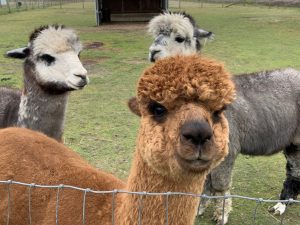
Popularity Explained
If you aren’t captivated simply by their sweet natures and adorable faces, consider alpacas’ light impact on the land. Their padded feet don’t damage pastures, and they cut grass with their teeth rather than pull out the roots. They leave trees alone. As part of the camelid family they don’t consume lots of water, and their efficient, three-compartment stomachs require less food than other livestock. They deposit feces in just one or two spots in the pasture—making for easy clean up and few parasite problems—and their poop can go straight to the garden as excellent fertilizer.
Considering the attributes of these animals, it’s no wonder they are increasing in popularity in the U.S. Since being imported from Peru in the 1980s, there are more than 50,000 alpacas in the country now.
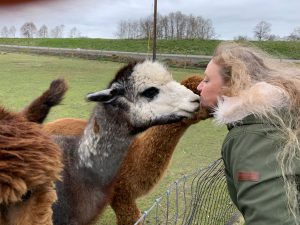
Take your family to South Fork Farms to meet Gary and Ruth’s four-legged family. The farm is primarily busy from April through the holidays, but the couple insists you can visit year-round. The Wiegands enjoy doing their part to preserve family farming in the Skagit Valley and showing visitors their operation. In 2013, they opened up The Bunkhouse Boutique in, you guessed it, the old bunkhouse on the property that housed the hired help a century ago. You can browse scarves, socks and sweaters, as well as natural fiber and yarn, and start on your holiday gift list.
To see the beautiful farm buildings and meet the animals online, visit the South Fork Farms website. Visit the Facebook page to see the farm and The Bunkhouse Boutique.





